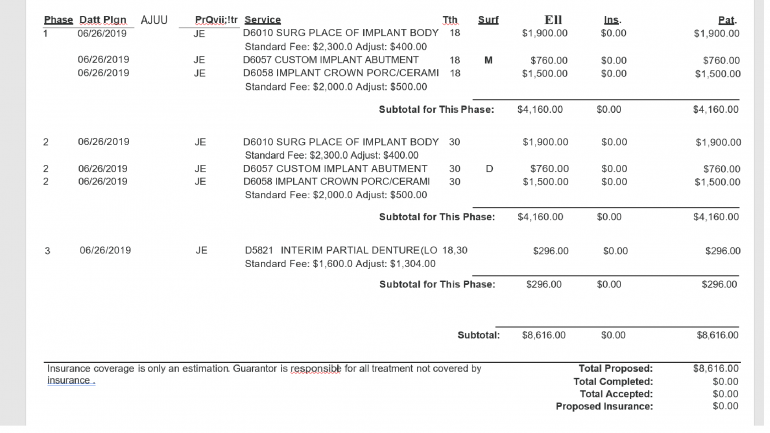
Dental Code D7251: Coronectomy – intentional partial tooth removal
Dental Code D7251 represents a specific dental procedure known as coronectomy, which involves the intentional partial removal of a tooth.
Dental Code D7251 Price Range
On average, patients pay $415 for this D7251 service at the dentist's office, with as little as $160 charged for this in less expensive cities and as much as $674 in more expensive cities.
Low cost of living | Medium cost of living | High cost of living |
Memphis (Tennessee), Cincinnati (Ohio) | Miami (Florida), Denver (Colorado), Austin (Texas) | (New York (New York), San Francisco (California) |
$160 | $415 | $674 |
However, the price for the service D7251 depends not only on the region where you live, but also varies from dentist to dentist. Therefore, it makes sense to compare prices before choosing a dentist. The best way to do this price comparison is at Dr. BestPrice and save a lot of money.
What does Dental Code D7251 mean? Detailed information about the procedure and the steps of the whole process
Dental Code D7251, also referred to as coronectomy, is a dental procedure performed in cases where the complete removal of an impacted wisdom tooth poses a risk to nearby nerves. Instead of extracting the tooth entirely, the dentist opts for a partial removal, leaving the tooth roots intact below the gum line. This technique significantly reduces the potential for damage to the inferior alveolar nerve, which runs in close proximity to the roots of the lower wisdom teeth.
Pre-operative Evaluation and Planning
Before proceeding with a coronectomy, the dental professional conducts a comprehensive evaluation of the patient's oral health. This evaluation includes taking X-rays, such as panoramic or cone-beam computed tomography (CBCT) scans, to obtain detailed images of the impacted tooth and its proximity to the nerves. These images help assess the risks and benefits of coronectomy for the individual patient.
Administration of Anesthesia
To ensure the patient's comfort throughout the procedure, local anesthesia is administered. The anesthesia numbs the specific area around the impacted tooth, minimizing any potential pain or discomfort during the coronectomy. The administration of local anesthesia plays a crucial role in ensuring patient comfort during the coronectomy procedure. Local anesthesia is typically injected near the affected tooth, numbing the surrounding tissues and nerve endings. This numbing effect enables the patient to undergo the procedure without experiencing significant pain or discomfort.
The dentist carefully selects the appropriate type and dosage of local anesthesia based on the patient's specific needs and medical history. Commonly used local anesthetics include lidocaine or articaine, which are known for their fast-acting and long-lasting effects. The dentist may also use a topical anesthetic gel to numb the gum tissue before administering the injection, further enhancing patient comfort.
Incision and Removal of the Crown Portion
Once the anesthesia has taken effect, the dentist makes a small incision in the gum tissue to gain access to the impacted tooth. This incision provides proper visualization of the tooth and the surrounding structures, allowing the dentist to perform the procedure accurately.
Using specialized dental instruments, the dentist carefully removes the crown portion of the impacted tooth. This involves separating the crown from the roots while ensuring minimal trauma to the surrounding tissues. The dentist may use instruments like elevators and forceps to safely and precisely remove the crown. During the removal of the crown portion in a coronectomy, the dentist employs their expertise and specialized dental instruments to carry out the procedure with precision and care. Dental elevators and forceps are commonly used to facilitate the separation of the crown from the underlying roots.
Preservation of the Root
Unlike traditional tooth extraction, coronectomy intentionally leaves the tooth roots intact below the gum line. This step is crucial to avoid potential damage to the nearby nerves, particularly the inferior alveolar nerve. By preserving the root, the risk of nerve injury is significantly reduced, while maintaining the stability of the adjacent teeth.
Irrigation and Closure
After the removal of the crown portion, the surgical site is thoroughly irrigated with a sterile solution to cleanse the area and remove debris. This irrigation helps minimize the risk of infection and promotes proper healing. The dentist then sutures the incision site using dissolvable or non-dissolvable sutures, depending on the case. Sutures aid in wound closure, support tissue healing, and minimize the chances of postoperative complications.
Summary of Dental Code D7251
In summary, Dental Code D7251 represents coronectomy, a valuable dental procedure performed when the complete extraction of an impacted wisdom tooth poses a risk to the nerves. Coronectomy involves the intentional partial removal of the tooth, leaving the roots intact below the gum line. By doing so, the potential damage to the inferior alveolar nerve and other nearby nerves is significantly reduced. Prior to the procedure, a comprehensive evaluation is conducted, and appropriate anesthesia is administered to ensure patient comfort. Coronectomy is a valuable option in cases where the preservation of nerve function is of utmost importance for the patient's overall oral health.
In conclusion, Dental Code D7251, or coronectomy, plays a vital role in managing impacted wisdom teeth while minimizing the risk of nerve damage. By understanding the procedure, patients can make informed decisions about their dental care. It is essential to consult with a qualified dental professional to determine the suitability of coronectomy based on individual cases and to receive proper guidance and care throughout the process.
Explore new horizons in dental savings with Dr. BestPrice! Your smile journey starts now.
